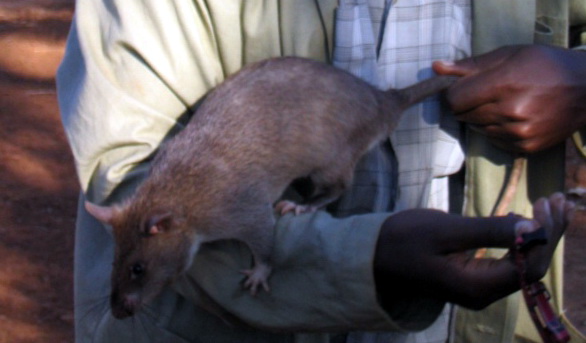Gambian Pouch Rat
From Wikipedia, the free encyclopedia
Order: Rodentia
Superfamily: Muroidea
Family: Nesomyidae
Subfamily: Cricetomyinae
The Gambian pouch rat (Cricetomys gambianus), also known as the African giant pouch rat is a nocturnal rat of the giant pouched rat genus Cricetomys. It is the largest muroid in the world. Native to Africa, it is an invasive species in Grassy Key in the Florida Keys, with great potential to damage native wildlife on the mainland; because of this it is illegal to import it into the United States.
Characteristics
The Gambian Pouch Rat can grow to be as big as a raccoon and can weigh up to 4 kg. It has very poor eyesight and so depends on its senses of smell and hearing. Its name comes from the large, hamster-like pouches in its cheeks. It is not a true rat, but is part of a uniquely African branch of muroid rodents.
In its native Africa, this rat lives in colonies of up to twenty, usually in forests and thickets, but also commonly in termite mounds. It is omnivorous, feeding on vegetables, insects, crabs, snails, and other items, but apparently preferring palm fruits and palm kernels.
Unlike domestic rats, it has cheek pouches like a hamster. These cheek pouches allow it to gather up several kilograms of nuts per night for storage underground. It has been known to stuff its pouches so full of date palm nuts so as to be hardly able to squeeze through the entrance of its burrow. The burrow consists of a long passage with side alleys and several chambers, one for sleeping and the others for storage.
The Gambian Pouch Rat reaches sexual maturity at 5-7 months of age. It has up to four litters every nine months with up to six offspring in each litter.
Males are territorial and tend to be aggressive when they encounter one another, otherwise this rodent is extremely friendly and has become popular as an exotic pet. It is intelligent, social and can be very gentle if handled from an early age.
In Africa, it is routinely eaten as bushmeat. It (and other mammals) are referred to by the pidgin name of "beef".
Problems from importation to the New World
Currently these rats have become an invasive species on Grassy Key in the Florida Keys. Perry et al. (2006) confirmed that animals found on the island are, in fact, representative of a breeding population and are not isolated escapees. It is unknown how the rat was released to the wild, and there is fear that if the rats reach Key Largo they could invade the Everglades and cause great ecological damage. As fruit eaters, the rats also pose a huge agricultural threat to South Florida, prompting USDA leadership in the trapping effort. Peterson et al. (2006) determined through computer modeling that C. gambianus (and, to a lesser degree C. emini) has strong potential to be a successful invasive across much of the mainland USA, particularly the southeast. Biologists say it would compete for food with native species, carry diseases, and damage the bird population by eating their eggs.
This outsized African rodent is also believed to be responsible for the current outbreak of monkeypox in the United States. In 2003, the United States' CDC and the FDA issued an order preventing the importation of the rodents following the first reported outbreak of monkeypox. Several African species are believed to carry the disease.
Pouch rats as mine-sniffers
A Belgian company has begun training Giant Pouch Rats to sniff out land mines. Due to their excellent sense of smell and tractable personality the Giant Pouch Rat has excelled in this application. They are clicker trained from an early age to associate the smell of explosives with a food reward, usually banana or a peanut. In the field, the rat wears a harness connected to a rope suspended between two handlers. Multiple rats sweep up and down an area about the size of a racquetball court one at a time and areas that the rats signal to (usually by stopping and scratching) are noted on a grid of the area. When an area has been thoroughly swept by the rats a team with metal detectors goes in and detonates all mines in the area.
Using Giant Pouch Rats in place of dogs has several advantages. The rats are indigenous to Africa where they are used and thus are well suited to the climate and are resistant to many endemic diseases. They are also widely available and inexpensive to procure. Training time is much shorter for rats than dogs and fewer resources are needed to raise a rat to adulthood, and Giant Pouch Rats have a relatively long life span.
In the field the rat's relatively small size means that it rarely detonates mines by walking over them. Both rat and rat handler teams are therefore safer than dogs and dog handler teams. Furthermore, large areas can be swept by multiple rats for multiple bombs before a detonation team goes in to explode the detected bombs. This cuts down on the time needed to search a particular area, since with dogs each land mine must be detonated as it is detected, to avoid the greater danger of search dogs detonating land mines. The rat's small size also means that many rats can be easily transported to and from field sites.
As with the use of dogs, land mines that have been manufactured to be completely sealed cannot be detected. These mines must be detected with metal detectors, since both dogs and rats use their sense of smell to detect trace amounts of explosive that leak from land mines.
http://en.wikipedia.org/wiki/Gambian_Pouch_Rat
| The text in this page is based on the copyrighted Wikipedia article shown in above URL. It is used under the GNU Free Documentation License. You may redistribute it, verbatim or modified, providing that you comply with the terms of the GFDL. |
|

